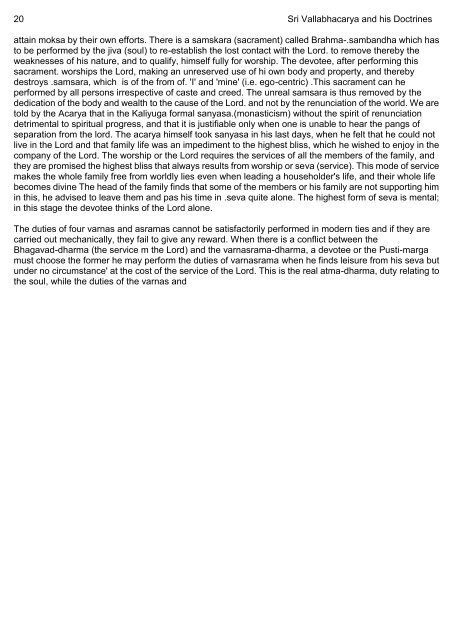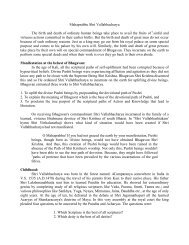Sri Vallabhacharya - Pushti Darshan
Sri Vallabhacharya - Pushti Darshan
Sri Vallabhacharya - Pushti Darshan
You also want an ePaper? Increase the reach of your titles
YUMPU automatically turns print PDFs into web optimized ePapers that Google loves.
20 <strong>Sri</strong> Vallabhacarya and his Doctrines<br />
attain moksa by their own efforts. There is a samskara (sacrament) called Brahma-.sambandha which has<br />
to be performed by the jiva (soul) to re-establish the lost contact with the Lord. to remove thereby the<br />
weaknesses of his nature, and to qualify, himself fully for worship. The devotee, after performing this<br />
sacrament. worships the Lord, making an unreserved use of hi own body and property, and thereby<br />
destroys .samsara, which is of the from of. 'I' and 'mine' (i.e. ego-centric) .This sacrament can he<br />
performed by all persons irrespective of caste and creed. The unreal samsara is thus removed by the<br />
dedication of the body and wealth to the cause of the Lord. and not by the renunciation of the world. We are<br />
told by the Acarya that in the Kaliyuga formal sanyasa.(monasticism) without the spirit of renunciation<br />
detrimental to spiritual progress, and that it is justifiable only when one is unable to hear the pangs of<br />
separation from the lord. The acarya himself took sanyasa in his last days, when he felt that he could not<br />
live in the Lord and that family life was an impediment to the highest bliss, which he wished to enjoy in the<br />
company of the Lord. The worship or the Lord requires the services of all the members of the family, and<br />
they are promised the highest bliss that always results from worship or seva (service). This mode of service<br />
makes the whole family free from worldly lies even when leading a householder's life, and their whole life<br />
becomes divine The head of the family finds that some of the members or his family are not supporting him<br />
in this, he advised to leave them and pas his time in .seva quite alone. The highest form of seva is mental;<br />
in this stage the devotee thinks of the Lord alone.<br />
The duties of four varnas and asramas cannot be satisfactorily performed in modern ties and if they are<br />
carried out mechanically, they fail to give any reward. When there is a conflict between the<br />
Bhagavad-dharma (the service m the Lord) and the varnasrama-dharma, a devotee or the Pusti-marga<br />
must choose the former he may perform the duties of varnasrama when he finds leisure from his seva but<br />
under no circumstance' at the cost of the service of the Lord. This is the real atma-dharma, duty relating to<br />
the soul, while the duties of the varnas and



